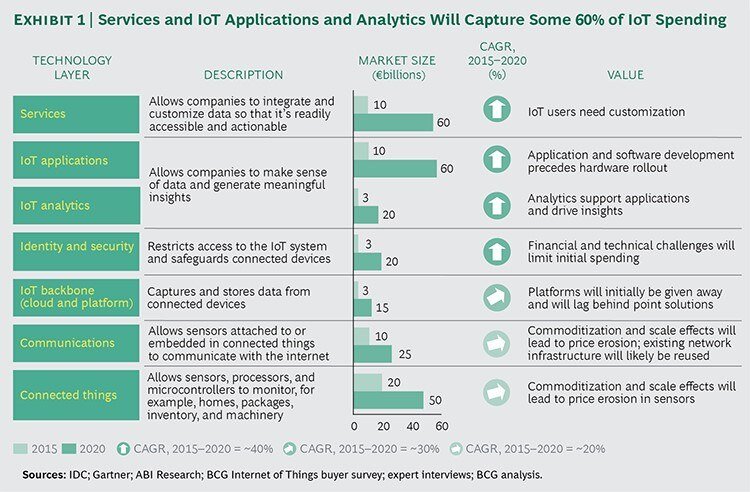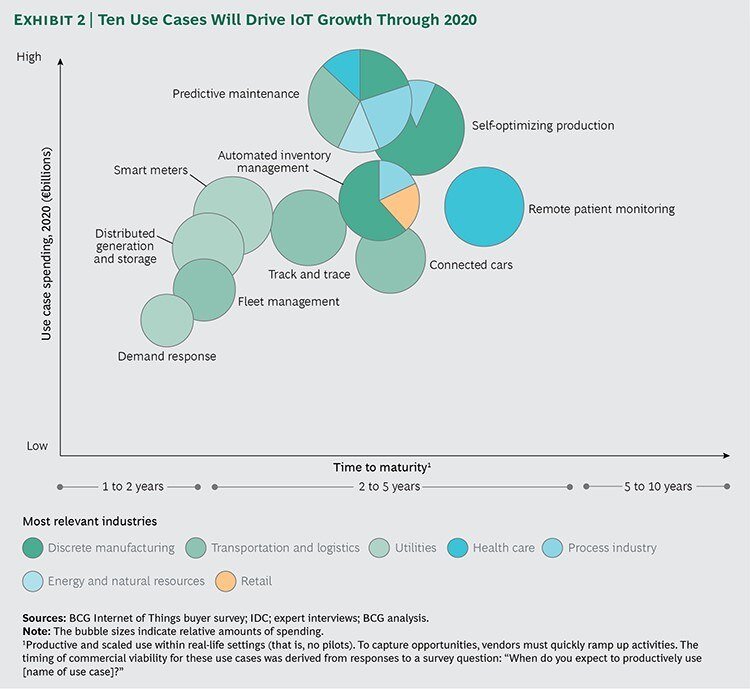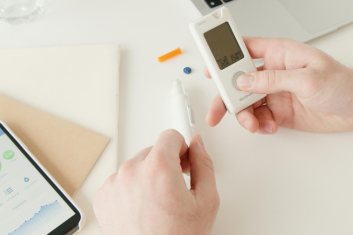The rapidly expanding demand for Internet of Things (IoT) tools and services is predicted to continue in the coming years. Gartner Inc. forecasts 31% growth between 2016 and 2017, with business expected to employ 3.1 billion connected items in 2017. For business, predictive maintenance and self-optimizing production are going to be two of the major drivers of this growth.
Substantial Growth Predicted
A recent report from Boston Consulting Group laid out a forecast through to 2020, which predicted compound annual growth rates of around 20%, with the result that by 2020 the overall IoT market would be worth EUR 250 billion.
Growth across IoT sectors is not expected to be even. BCG sees the main areas of growth potential being focused on services and then IoT analytics and applications (see image below). Together, services and IoT analytics/applications are expected to account for approximately 60% of IoT spending.
Separately, in 2016, Business Insider projected that by 2020 there would be some 34 billion devices connected to the internet – up from 10 billion in 2015 – with IoT accounting for 24 billion.
In terms of sectors, it is Transportation and Logistics, Discrete Manufacturing, and Utilities that BCG expects to account for around 50% of all IoT spending. The drivers behind this predicted growth are heavily linked to businesses and business leaders recognizing that there are major benefits to be gained from exploiting IoT to solve business challenges.
There are broadly ten areas or ‘use cases’, as shown in the image below, around which the development of IoT will focus. Of these, predictive maintenance and self-optimizing production are expected to be the two largest elements.
Predictive Maintenance
The aim for businesses that are looking to IoT in this area is to reduce the costs associated with maintenance, and the idea of machines or systems that can take care of themselves is clearly a highly attractive one for businesses.
Considerable expense of time, money, and labor would be saved if equipment undertook self-maintenance or altered the company ahead of any problems developing. Such IoT-enabled machines and systems would allow for maintenance to take place when it is actually needed and not just according to standard schedules or ‘rule of thumb’. It would reduce the need for manual intervention, for example in the areas of provisioning, updating, and even to a degree with the disposal.
A 2017 report by Deloitte summarises it well: “Traditionally, maintenance professionals have combined many techniques, both quantitative and qualitative, in an effort to predict impending failures and mitigate downtime in their manufacturing facilities. Predictive maintenance offers them the potential to optimize maintenance tasks in real-time, maximizing the useful life of their equipment while still avoiding disruption to operations.”
Expanding Uses
Predictive maintenance, as a concept and as being used, is not new. In some sectors, it has been standard practice for years. However, the growth of IoT offers the chance for its users to expand beyond those sectors that have traditionally looked at using it.
With more accessible and easily useable IoT applications and devices, predictive maintenance is forecast to cover a whole range of sectors from infrastructure and utilities, to manufacturing, healthcare, and transport and logistics (amongst others). In scale, it will vary from single unit devices at one end (a printer, an individual street light) to entire complex manufacturing systems or transport infrastructure at the other (such as monitoring of entire railway networks or off-shore wind farms).
Benefits of Predictive Maintenance
In terms of the gains to efficiency, while highly dependent upon the individual industry or sector involved, greater efficiency in maintenance could result in improvements of anywhere between 5-20%, with substantial material cost savings of between 5-10% predicted by Deloitte.
Other benefits include reduced inventory carrying costs (due to less machine breakdown/wear out), increased equipment uptime, reduced maintenance planning time (20-50% less), reduced overall maintenance costs (5-10%), and improved health and safety compliance.
There are also further effects that successful predictive maintenance can have on the operations of a firm. By demonstrating that the effective use of data can make a real difference to resource expenditure, wider acceptance of the use of data for decision making and planning activities can be generated. Greater confidence and acceptance of decisions could result and ultimately improved business profitability. Clearly predictive maintenance is not a ‘one-size-fits-all’ tool. Its use needs to be highly bespoke and suited to the individual company, technology, or item in question. Companies will have to be aware of the limitations of predictive maintenance and ensure that there are still enough appropriately skilled staff to perform tasks.
Clearly predictive maintenance is not a ‘one-size-fits-all’ tool. Its use needs to be highly bespoke and suited to the individual company, technology, or item in question. Companies will have to be aware of the limitations of predictive maintenance and ensure that there are still enough appropriately skilled staff to perform tasks.
The wholesale gutting of maintenance departments will certainly not be an advisable outcome, although the situation of management asking ‘with this IOT predictive maintenance, how many people can we get rid of?’ can easily be foreseen.
Self-Optimizing Production
BCG defined self-optimizing production as: “Connected factories and plants can use IoT to monitor and optimize production processes in real time, making automated adjustments to improve quality, enhance efficiency, and reduce waste. This use case is ideal for discrete manufacturing and process industries.”
The idea of having manufacturing facilities that are able to automatically respond to both internal and external events is highly attractive and the possibilities are considerable – automatic expansion of production in response to a surge in sales, a reduction in production at certain times of day when energy prices cross a certain price threshold, or automatic changes to the production process following automated internal quality control testing.
The advantages that can be gained here can, amongst other areas, relate to increases in the speed of adjustment, less resource involvement, and more identifiable results from the impact of changes. Overall, the effect should be an improvement in quality and cost-basis.
Use Cases
One potential example could be a manufacturing plant that is linked into IOT monitoring of energy prices to automatically shut down in response to a price rise, which undertakes systematic quality checking activities and that can adjust the production tools and processes to correct for any defects that are detected. These changes can be done instantly, without the need for management discussion and delays in decision making.
There will be limits to the ability of production to self-optimize – clearly the tools available play a major role as will the level of programming and options that are available to any system. But in terms of gaining percentages improvements in quality and cost, the potential is considerable.
Summary
The opportunities for business that are offered by IOT are substantial, with predictive maintenance and self-optimizing production being two of the major investment areas through to 2020. While there is unlikely to be any one silver bullet or single application that can solve every problem, those businesses that keep an ear to the ground and invest in IOT solutions for predictive maintenance and production optimisation stand to gain substantially and improve their competitive advantage to those that do not.

HQSoftware Founder
Having founded the company in 2001, uses his broad knowledge to drive the company forward. Ready to share his wisdom on software development and technology insights
Related Posts
View All
We are open to seeing your business needs and determining the best solution. Complete this form, and receive a free personalized proposal from your dedicated manager.

Sergei Vardomatski
Founder







